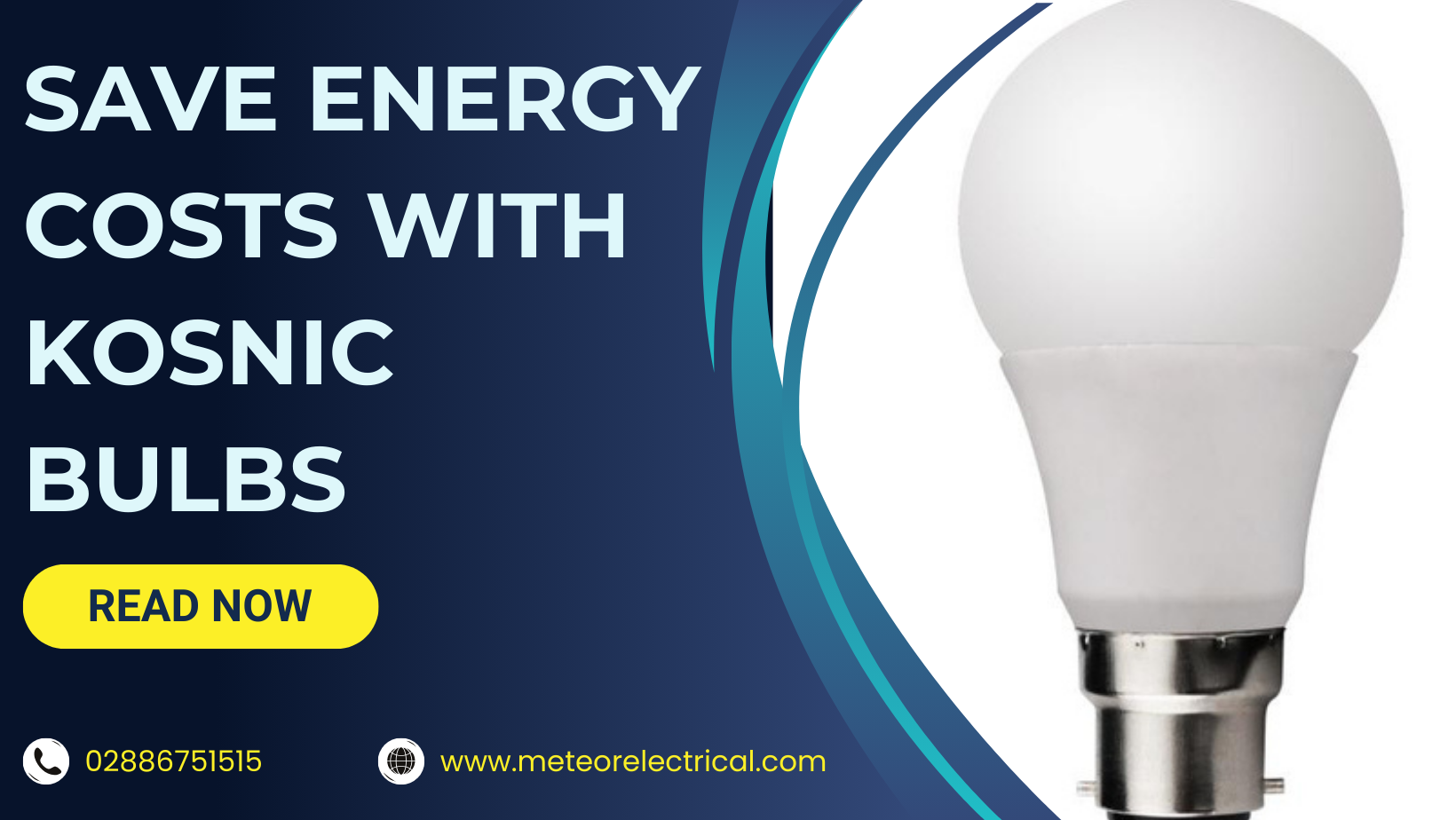Save on Energy Costs with Kosnic Bulbs
Inefficient light energy can be a major contributor to high electricity costs. Many consumers are switching to LED lighting products to save on energy costs and use electricity more efficiently. Kosnic has created a line of high-quality LED light products that provide high-grade without compromising on illumination.
LED light bulbs are the modern way of illuminating spaces as they cut down on electricity costs and are considered more environmentally friendly than their traditional counterparts.
Energy efficient lighting is increasing in popularity, and many manufacturers are using innovative technology to improve light input while maintaining efficiency. Here is everything you need to know about Kosnic bulbs.
What Is Energy Efficient Lighting?
Before we look at the Kosnic Bulbs range of energy efficient lighting, it is important to understand what these light products are and they work. Energy efficient luminaires reduce the energy usage of the light bulb without affecting the final lumen output or brightness.
An energy efficient light fixture consumes less energy to perform the same function as a traditional lamp. These qualities form the basis of energy efficient lighting. Energy efficient lighting does not rely on wattage to deliver good results. It is important to understand that energy consumption does not correlate to the quality of brightness.
Energy efficient lighting can help you save energy while providing high-quality illumination. If you are looking to introduce energy efficient lighting in your home, you don’t have to go through a complicated process.
There are several ways to implement energy efficient luminaries. You can simply conduct a re-lamping. This includes replacing old traditional lamps such as incandescent bulbs with energy efficient LEDs or fluorescent light bulbs.
Apart from light bulbs, you can also introduce better and more efficient lighting controls. These controls give you precise control of your light energy consumption. Energy efficient lighting also has better structural integrity than other lighting.
These luminaries have better circuitry than conventional lights, stopping electricity from going to waste. These lights are also designed to last a lot longer than traditional lighting. Due to this quality, you won’t have to spend a lot of money trying to replace your light bulbs often.
A common feature in some energy efficiency lights is a dimmer switch. This switch provides even more efficient use of your energy. Apart from replacing your light bulbs, you can also follow alternative methods of using your light efficiently.
Many homeowners introduce energy efficient lighting in their households to reduce energy bills; however, you can also implement such lighting in a larger application. Energy efficient lighting in commercial buildings and public luminaries will greatly impact energy savings and carbon emissions.
Several government legislatures are implementing the use energy efficient lighting on a larger scale to cut back on energy consumption and reduce environmental harm. These legislatures are urging manufacturers to scale back on the production of inefficient lighting. In fact, the UK plans to phase out all inefficient lighting by 2023.
Some governments are also incentivizing manufacturers to produce more efficient light solutions. The awareness of energy efficient lighting is also increasing, and many people are seeking out energy efficient bulbs instead of their traditional counterparts.
Due to this high demand, you can expect the energy efficient light industry to reach £324 billion by 2027. With high demand, there will be many more economical and efficient light products to choose from in the future. You can find such products in our line of Kosnic bulbs.
The Kosnic bulbs are one of the best lighting products on the market that use innovative LED technology with lower upfront. With these fixtures, you can enjoy energy efficient brightness at just a fraction of the cost.
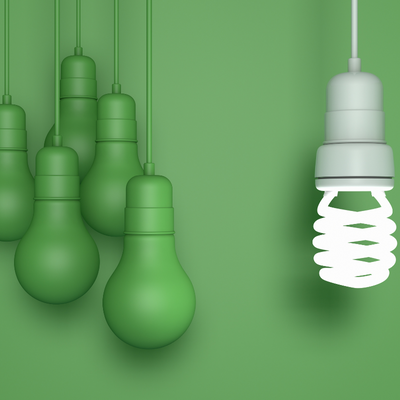
Why Switch To Energy Efficient Lighting?
Some energy efficient lighting has high upfront costs, which might make consumers apprehensive about switching to energy efficient solutions; however, these lights are highly beneficial in the long run as they produce energy savings.
Lighting is an important basic requirement of any building, whether it's residential or commercial. Lighting is a significant part of our daily life and impacts our day-to-day activities. Since lighting is so important, it also consumes a significant portion of energy.
Such high energy consumption levels are not sustainable, and you will experience higher energy costs in the future. To combat such issues, energy efficient lighting is crucial. Lighting takes up a major portion of global energy consumption.
Even in smaller capacities, it can consume a lot of energy. In a household, lighting takes up 15% of the total energy consumption. When it comes to large scale applications such as industrial usage, lighting can be a major source of energy consumption.
26% of Europe’s total energy usage comes from light sources. No matter the application, lights are a major contributor to high energy costs; therefore, it is important to invest in energy saving alternatives to make a more sustainable impact.
Energy efficient lights play a key role when it comes to energy saving. Since these are major sources of electricity consumption, you can expect major savings when you make the switch to energy efficient lighting.
Traditional incandescent lightbulbs are responsible for high energy consumption due to lighting. These traditional light bulbs, such as incandescent and halogen bulbs, not only waste energy but also produce a lot of heat, damaging the light bulb and requiring frequent replacements.
Once you install energy efficient lighting, you might not see a lot of savings immediately; however, you will experience a major reduction in your energy bills after some time. Here are some important areas where you must implement energy efficient lighting to reduce energy consumption:
- Residential properties: domestic properties, apartments, and other housing facilities are a great place to implement energy saving lighting. Many homeowners can enjoy major energy saving benefits when switching to LED light solutions. This area is also a great place to spread awareness about energy efficient lighting to increase its use over time and create a positive environmental impact.
- Commercial properties: areas such as shopping centres, malls, restaurants, and other such places are almost always in use, sometimes even 24/7. Since these places get a lot of people, it is important for them always to be well lit up, and this much electricity consumption can lead to very high energy costs. However, commercial properties are also a great place to experience high energy savings when switching with energy efficient lighting solutions. These luminaries will have a similar impact as domestic energy efficient lighting but on a larger scale.
- Industrial complexes: The industrial sectors function 24/7 and consume a lot of power. This consumption does not only cover lighting but also includes construction equipment and production methods; therefore, it is important for industrialists to switch to energy efficient lighting in order to reduce energy costs. Inefficient lighting in this area can also be a major contributor to greenhouse gasses which is why it is important to switch to sustainable light sources.
With these applications, it is easy to see how much different energy efficient lighting can make in the long run. These light solutions are not only energy efficient, but they also last a long time due to their high-quality structural component. Energy efficient luminaries also reduce environmental impact and also reduce heat energy consumption.
If you are looking for energy efficient bulbs that are versatile in terms of application, look no further than our Kosnic bulbs range. These Kosnic luminaries come in a variety of configurations, making them suitable for many applications.
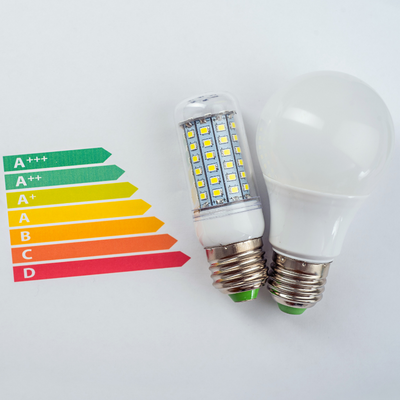
What Are The Four Different Types Of Light Bulbs?
Before energy efficient LEDs, there were several different models of light bulbs that were considered very effective when they came out. However, with every technology and appliance, these models have become outdated.
Older light bulb models are not as efficient as the current LEDs. However, it is important to look back at these bulbs and see all the mechanical innovations that led us to energy efficient lighting solutions. Here are the four different types of light bulbs throughout the years.
Incandescent Light Bulbs
Incandescent or traditional light bulbs were invented over 100 years ago and are often considered one of the earliest iterations of luminaries. These light bulbs are still widely used in many parts of the world. However, this usage has become very controversial.
Incandescent bulbs consume a lot of energy and are very detrimental to the environment. Due to this quality, many governments are phasing out these bulbs. Incandescent light fixtures have a piece of hard metal wire, and this wire has an extremely high melting point.
The wire is generally made from tungsten, and a glass cover surrounds it. These types of light bulbs are extremely high energy consumers and are highly inefficient. One of the biggest problems with these bulbs was their mechanical components. The hard wire structure in traditional light bulbs has an extremely high melting point.
This wire is made from tungsten, and it is surrounded by a glass cover. When electricity passes through the light bulb, the wire glows and produces light. This light is what we see when the bulb is turned on. These components make up the structural form of an incandescent light bulb. These light bulbs were effective in the earlier time period as many people did not have sufficient light sources.
However, due to innovative technology and environmental consciousness, these incandescent or traditional light bulbs are now considered highly inefficient. It is also important to note that these bulbs are not as bright as modern LEDs, even at the same wattage.
Incandescent bulbs are also one of the most inefficient light bulbs, as the majority of the energy consumed by these fixtures goes to waste. Only 10% of the electricity used by a traditional lightbulb is converted into visible light, while the rest is wasted. This figure shows that roughly 90% of your electricity goes to waste with traditional light bulbs; therefore, you end up spending a lot of money on wasted energy.
In comparison, energy efficient luminaries with a similar wattage use almost all of the energy consumed. Additionally, traditional incandescent light bulbs have a far shorter lifespan than energy efficient light fixtures, which means extra replacement costs. These traditional bulbs are not meant to last long due to their mechanical components. The filament in an incandescent light bulb burns out quickly due to heat emissions.
High heat emissions are also a major limitation of incandescent bulbs; however, you won’t find this issue in energy efficient lighting. To solve such inefficiency issues, manufacturers came up with several other ways to make light bulbs more efficient.
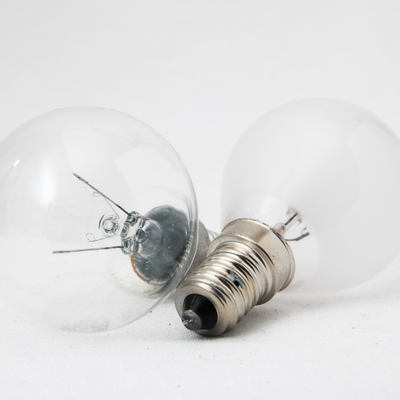
How To Dispose of Incandescent Light Bulbs?
Most modern-day incandescent light bulbs are made from non-toxic materials, which means you can dispose of them with your garbage; however, these bulbs are not recyclable.
Make sure to check out recycling options before disposing of incandescent light bulbs. Also, ensure that you put these bulbs inside another material, as the glass can break easily.
Halogen Light Bulbs
In an effort to create energy efficient lighting, manufacturers introduced halogen light bulbs as a replacement for incandescent lighting. These were considered to be more efficient than incandescent bulbs.
Halogen light bulbs use a similar filament technology as traditional light bulbs, but these luminaries run at a higher temperature. Despite the newer mechanisms, halogen light bulbs are only slightly more efficient than incandescent light bulbs. However, in terms of brightness, halogen lamps burn far brighter than incandescent bulbs.
Manufacturers introduce a different set of components in these bulbs to make them better than incandescent bulbs. Halogen lights contain a small amount of halogen gas which mixes with the tungsten vapor from the wire. The mixture makes its way back onto the filament instead of going inside the bulb. This process allows a halogen bulb to shine brighter than a traditional bulb.
Additionally, this mixture also extends the lifespan of the bulb slightly longer than an incandescent light bulb. Halogen light bulbs are commonly used in spotlight sockets and fittings. However, manufacturers are forgoing these light bulbs for even more efficient light bulbs.
Along with traditional or incandescent light bulbs, lower-level halogen light bulbs are being removed from the market for more energy efficient alternatives. The use of halogen bulbs has been on a steady decline, and the UK is set to phase out these lights so that LEDs make up 85% of luminaries sales across the country.
Due to modern technological advancements and environmental concerns, many governments started backing manufacturers that produced an even more efficient form of lighting. After the halogen light bulbs, modern replacement models were designed that produced the same level of illumination but used less electricity.
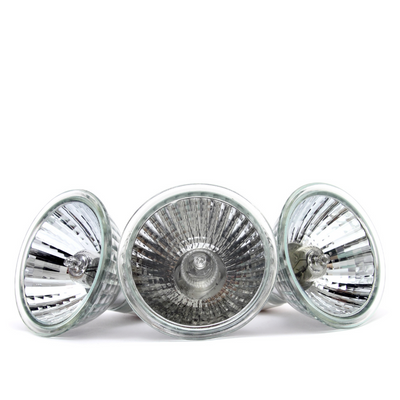
How To Dispose of Halogen Bulbs?
Halogen light bulbs can be thrown away safely in your household garbage as they pose little environmental threat; however, these bulbs are also difficult to recycle.
Unlike incandescent light bulbs, halogen lamps are made from thicker glass; therefore, they won’t break as easily. Despite the glass, you should still wrap the halogen bulb in another material before throwing it away.
Compact Fluorescent Light Bulbs
Compact fluorescent lamps, or CLFs, were the first light bulbs that were specially designed as an energy efficient light solution. These luminaries were considered far better than their previous models are were created to use energy more efficiently.
CFL bulbs have a much longer lifespan than both incandescent and halogen lamps, as they can last over 8000 hours. When it comes to energy consumption, compact fluorescent lamps use approximately 70 to 80% less electricity than incandescent light bulbs. These light fixtures have a very different structural makeup compared to previous light bulbs.
CFL bulbs contain a gas called argon inside a glass tube. This gas also contains small amounts of mercury vapor. When the mercury vapor and argon react, they create an ultraviolet light, which is invisible to the naked eye, but once this light passes through a fluorescent coating in the tube, it emits visible light.
CFL light bulbs marked a big step toward energy saving light bulbs. However, these were still not as efficient as LED lights.
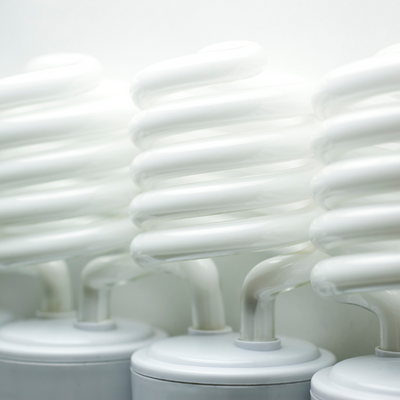
How To Dispose of CFL Light Bulbs?
If you want to dispose of CFL light bulbs, you need to take special precautions to reduce any contact with mercury. As mentioned before, CFLs contain a small amount of mercury vapor that can be extremely harmful.
To avoid any danger, you must consult your local hardware and electrical stores. In most cases, these stores will recycle the bulb for you. Alternatively, you can contact your local energy service provider and asks for steps on how to dispose of CFLs.
Light Emitting Diode Light Bulbs
After CLFs, manufacturers designed an even more efficient light model. These were called light emitting diodes or LED light bulbs. In most applications, LED lights have replaced CFLs as the more energy efficient light model out of the two.
When it comes to energy efficient lighting, many people prefer using LEDs instead of other lighting alternatives. Due to environmental consciousness, the awareness of these bulbs is steadily increasing.
Energy saving LEDs, such as the Kosnic bulbs, are highly versatile and can be used for domestic and commercial applications. These bulbs come in a linear fluorescent lamp or strip light format, which is commonly used in the workplace and industrial settings.
As mentioned before, structural features play a key role in a light’s efficiency, and an LED bulb is no different. Due to their physical characteristics, LED lights are far more efficient than other light bulbs, especially incandescent lights.
LED light has a powerful light bulb structure that is highly energy-efficient. When these LED bulbs were first created, they were created in a single-bulb structure. Early LED light bulbs were used in electronic appliances, instrument panels, pen lights, and more.
Once these lights were produced in small grouped clusters, they had a wider appeal in terms of applications. More recent use of energy efficient LED light bulbs includes indoor headlamps, recessed lighting, string lighting, and Christmas lights. With the rising popularity of energy efficient lighting,
LED luminaries are becoming one of the most popular light sources worldwide. LED lights are equipped with a standard base fixture similar to other bulbs for domestic and household purposes. Another great feature of LEDs is the lens. The diffuser lens is a crucial component as it helps the light spread in a wider beam.
One of the major features of early LED light bulbs is that the light emission is directional. This makes LEDs different from incandescent light bulbs as they spread light in a spherical direction. This type of lighting direction works well with recessed lighting or under cabinet lighting fixtures; however, directional lighting may not be suitable for table lamps.
Modern LED light bulbs are created to address directional light limitations. These newer LED lights use a diffuser lens and a reflector to distribute illumination in multiple directions, similar to an incandescent light bulb. Despite the high energy savings with LED light bulbs, these bulbs have a high upfront cost for many consumers.
LED light bulbs also have a high production cost which is a major roadblock to the widespread use of LED bulbs. However, modern research and technology are rapidly evolving to designing much more efficient, and cost-friendly LED light bulbs.
Even if you purchase a more expensive model of LED bulbs, you will experience savings in the long run. LEDs help you save on energy because they do not rely on wattage to deliver high-intensity illumination.
LEDs use lumens as a way to measure their light output instead of watts. This means that even if you purchase an LED with a high lumen output, it will still take up less energy than an incandescent bulb with a similar lumen output.
The Kosnic bulbs line uses similar measurements to deliver robust results. In this range, you will find products that use very little wattage but provide high-grade brightness to help you save on energy costs.
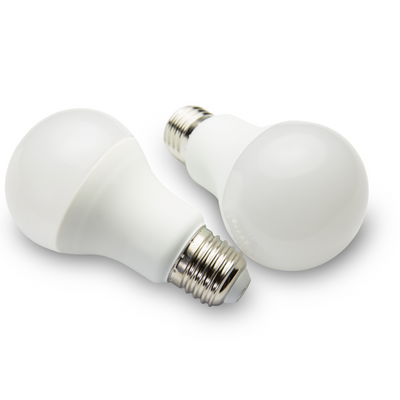
How To Dispose of LED Bulbs?
LED bulbs are very easy to dispose of because they do not contain any dangerous chemicals. Therefore, you can follow similar guidelines as the incandescent and halogen light bulbs.
However, most LED lights are made from recyclable materials, so that you can include them with other recyclable items. Before you add the LEDs to the category, make sure to check with your recycling provider.
How Do Energy Efficient LEDs Compare To Other Light Bulbs?
When it comes to choosing the best energy efficient light bulb, LEDs come out on top. LED light bulbs are far more efficient than any other light product on the market. This lighting solution uses 90% less energy than an incandescent or halogen light bulb of similar brightness.
For example, a 4-watt LED light bulb can achieve a similar lumen output comparable with a 50-watt halogen light bulb. This is because LED light bulbs are much more efficient at converting electricity into light energy. The Kosnic bulbs are designed to be highly efficient as they use very low wattage to operate while focusing on the lumen output.
The mechanical features of LEDs make a key difference in this conversion because, in other light models, most of the energy would get wasted as a heat emission. However, LED lights do not produce heat; therefore, they make much better use of the energy consumed.
In terms of efficiency drops, LED light bulbs perform better for a long period of time compared to other light bulbs. LEDs experience a drop in efficiency as the current increases; however, the overall performance drop is much lower than an incandescent light bulb.
With innovative research, manufacturers are looking at ways to extend a LED's life even further. On the other hand, incandescent bulbs have an extremely short lifespan when compared to LEDs, making them an inefficient lighting solution for prolonged use.
Another great benefit of using LED light bulbs is the longer lifespan. Since there is no thermal emission, the LED bulb does not suffer any damage and therefore does not need constant replacements. A well-built LED light bulb can last 25 times longer than any other light bulb.
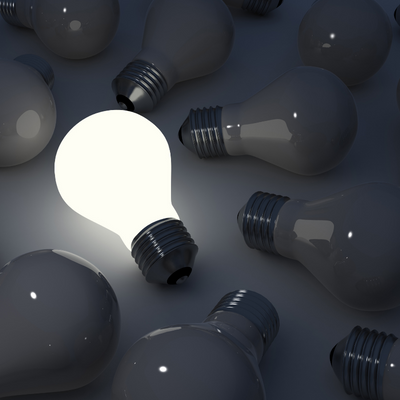
How To Measure A Light’s Efficiency?
There are several variables that affect a light’s efficiency. Before you purchase energy efficient lighting, there are several features you must consider to make sure you have the best energy saving light bulb.
Measure Power Usage With Watts
In light sources, watts measure the unit of power required to operate the light bulb. Most electricity measure this output through kilowatt-hours to determine how much you will be charged for light energy consumption.
When looking to purchase a light bulb consider the maximum wattage rating of the light fixture, as this will determine the cost of electricity. Since incandescent light bulbs depend heavily on wattage to deliver appropriate brightness, you will end up spending a lot of money on these light bulbs.
Another factor to consider about wattage is the heat emissions. The electricity flow to the light bulb generates heat, usually in incandescent bulbs; therefore, higher wattage means a higher heat emission.
To avoid such issues, you must consider bulbs that operate with a lower wattage than their fixture ratings. These bulbs are much safer and more energy efficient. LED light bulbs operate at a lower wattage and generate little to no heat, making them a suitable option for many applications.
Also, make sure to check the light fixture’s rating before purchasing a bulb. A light bulb that draws more watts than its fixture will result in overheating, damaged wiring, and a fire hazard.
Measure Light Emissions With Lumens
When incandescent light bulbs were the popular light source, wattage was used to determine the level of brightness. However, with the invention of LED light, manufacturers have created a different method of measuring light output.
Lumen is now considered one of the best measures of light intensity. If you are looking to replace incandescent light bulbs with LEDs, you should look for the lumen output instead of the wattage. Here are some important watts to lumens conversions you must remember:
- If you want to replace a 100W incandescent light bulb, look for an energy efficient bulb that provides 1600 lumens.
- To replace a 75W bulb, look for an 1100 lumens bulb
- To replace a 60W bulb, look for an 800 lumens bulb
- Replace a 40W bulb with a 450 lumens bulb.
Even with LEDs, there is a wide variety of choices when it comes to lumen output. There are some LED models that achieve significantly high lumens with a low wattage figure. However, as a general rule, you can easily replace a 100W standard light bulb with a 1600 lumens energy efficient light model.
Another factor to consider regarding light intensity is how many light bulbs you need to reach your desired level of brightness. Some spaces do not need to be as bright. Therefore, they might not require a bulb with a high lumen output.
For example, you might want the living room and kitchen to be more brightly lit than the hallways. Make sure to assess your brightness requirement before looking at the lumen output.
Consider The Colour Temperature
Another important factor to consider when purchasing a light bulb is the colour temperature. The light bulb’s colour temperature is important as it determines the mood and atmosphere of a room.
For a warm and comfortable environment, many consumers prefer using warm white lamps in their households. Alternatively, bright white light bulbs are preferred in retail and office spaces as they illuminate everything clearly.
Most light bulbs are designed to emit light in a spectrum ranging from yellow to blue. When purchasing light bulbs, you will notice that the colour scale is often measured using the Kelvin Colour Temperature Scale, and you will see the unit denoted with a K.
It is important to note that 2700K on the Kelvin scale refers to a very yellow light and 7000K is very blue. Therefore, the higher the Kelvin unit, the brighter the white light. Different colour temperatures work well for different applications and ambiances.
In general, yellow light is used for a warm and relaxed ambiance, while blue light is used for alertness and clarity. Here are some ways you can use the colour scale to find your preferred colour of lighting:
- Light bulbs with a temperature between 2000K and 3000K are great for bedrooms, dining rooms, and living rooms. These bulbs often come in the shade of warm white.
- Lights between 3500K and 4000K are better suited for locations where you need clear illumination, such as bathrooms, kitchens, and office spaces. Bulbs in this range come in the shade of neutral white or cool white.
- The 4500K light bulb range is suitable for work and construction areas where clarity and details are more important than the ambiance and environment. These bulbs work best for reading and table lamps, and you can also use them for vanity tables.
- Lights in the 5000K range and higher are better suited for workshops and garages.
With these factors in mind, you can easily find the best possible energy efficient light to fit your lighting needs.
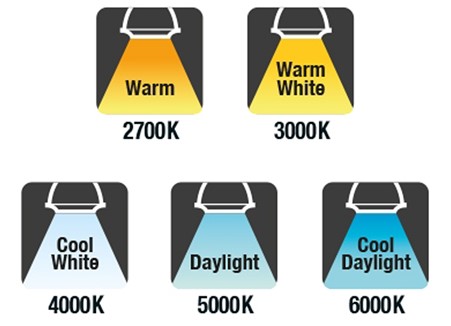
What Are The Best Energy Efficient Lights On The Market?
There are several great options for energy efficient lighting; however, the sheer volume of choices can be overwhelming, and it is difficult to know which bulb is the most reliable. If you are looking for a range of lighting that gives you energy savings without compromising brightness, visit Meteor Electrical.
At Meteor, you can browse through our Kosnic range for energy efficient lighting solutions. Kosnic is a leading manufacturer and expert in energy efficient lighting solutions with products available worldwide. Kosnic bulbs provide high-quality lighting that will use your energy efficiently with high-quality illumination.
Here are some of the best Kosnic bulbs you can find at Meteor.
-
Kosnic 9W LED Light Lamp.
If you are starting out with energy efficient lighting, you will prefer the Kosnic 9W LED light lamp. This bulb is a great addition to any household or commercial property and will help you reduce your energy bills in the long run.
This bulb has a total lumen output of 730, and it can last for 20,000 hours. With these specifications, you will not have to worry about the bulb’s brightness or the replacement costs.
-
Kosnic 4.5W 390 Lumens Cool White Lamp
This Kosnic lamp is created for workspaces and is highly efficient, using up 92% of energy. This quality makes sit one of the most energy efficient light bulbs on the market. This lamp also comes with a very long lifespan of 30,000 hours which means less money spent on replacement costs. If you are looking to replace halogen lamps with an energy efficient solution, this Kosnic lamp is a great option.
-
Kosnic 4.5W LED Lamp
Looking for another alternative for halogen bulbs, replace your halogen lamps with the Kosnic 4.5 LED lamp. This light fitting offers high energy savings without compromising on brightness. This Kosnic lamp is incredibly high-performing with a 390 lumen output. You can use this LED lamp for both household and hospitality purposes.
-
Kosnic 4 Watt Bayonet Candle LED Light
The Kosnic 4W filament candle light is highly efficient and functional as it provides 100 lumens per wattage. With this light, you get high-quality brightness and major savings without compromising on brightness. This light has a more traditional aesthetic compared to other modern, efficient lighting. However, it has high-grade technology with a lifespan of over 20,000 hours.
-
Kosnic 5 Watt Frosted Bayonet Cap LED
This 5 Watt frosted bayonet lamp is part of Kosnic’s energy efficient and affordable LED light range. This light bulb has a lifespan of 20,000 hours and is very easy to install, so you can easily replace your traditional light bulb with this Kosnic lamp. This lamp provides warm white lighting, which makes it ideal for households.
-
Kosnic 5 Watt Frosted Bayonet Candle Lamp
The 5 watt frosted candle bulb is a versatile lamp that can work in many applications. This lamp is also highly efficient and can save you up to 85% of energy costs compared to incandescent or traditional light bulbs. With a lifespan of 20,000 hours, you can don’t have to worry about maintenance costs.
Final Takeaway
Energy efficient lights are a great way to cut back on energy costs without compromising your light’s brightness. These lights are far better than their traditional counterparts and work for a long period of time. For the best energy efficient bulbs, visit Meteor Electrical and browse through our Kosnic light range.

